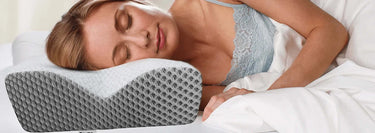Matching Elevation Height to Your Body Geometry for Balanced Support

When you first start using a leg wedge, it is natural to focus on the product name, the foam, and the cover. But one factor quietly decides whether your body feels supported or forced: height.
A wedge that is too low does not give your legs much change from lying flat. A wedge that is too tall can feel like you are being pushed into a sharp bend at the hips. Somewhere in between is an angle that feels natural for your height, sleep position, and daily routine.

This guide explains how to choose the right leg elevation height by body size, and how to balance two key ideas:
- Upward incline sessions – a slightly higher angle designed for a short-term daily reset.
- Ergonomic alignment support – a gentler incline built for everyday posture, back tension relief, and longer use.
Both have their place. Your body simply needs the right height for the right purpose.
Why Wedge Height Matters For Comfort And Alignment

Leg elevation is not only about raising your feet. The whole point is to create a neutral, supported position from hip to heel so your lower body can let go of daily tension. Height is a big part of that.
When the wedge is sized correctly:
- Your thighs rest along the slope without a big gap.
- Your knees stay slightly bent but relaxed, not sharply folded.
- Your calves and heels feel equally supported and do not slide off the edge.
- Your hips and lower back feel like they can settle rather than brace against the angle.
When height is off, the body has to work to hold the position. A very tall wedge can pull on the front of the hips, creating more tension in the lower back. A very low wedge does not give your legs enough range of motion from lying flat to feel like an active reset.
The goal is a height that makes your body say, “I could stay here comfortably for 15 to 20 minutes without fidgeting,” not “I need to get out of this position.”
How Body Size Changes the Ideal Elevation Angle

(Above) This diagram shows how different wedge heights match different body sizes. Shorter users (5'0"–5'6") typically align best with a 9-inch wedge, medium-height users (5'7"–5'11") match well with a 10-inch incline, and taller users (6'0"–6'5") use the full 11-inch height. The visual highlights how each person settles into a smooth leg path when the incline fits their proportions.
Height is only part of the equation. Leg length matters as much. For example, someone who is 5'2" with a 28-inch inseam may prefer the 10-inch wedge if their legs naturally track better along a slightly taller incline. The goal is a clean thigh-to-calf transition that feels balanced, rather than forcing the knees too high or leaving the legs under-supported.
What Happens When the Elevation Height Is Too High

(Above) This illustration shows a shorter user lying on a taller wedge than their leg length can support. The red cues highlight where the geometry becomes exaggerated — knees lifting too high, hips angling forward, and the lower legs losing a smooth resting path. The point isn’t discomfort; it’s simply a mismatch between body size and incline height. A lower wedge solution keeps the leg curve more natural and predictable.
What Happens When the Elevation Height Is Too Low

(Above) This diagram shows a taller user on a wedge that’s too small for their leg length. The red arrows show where the incline no longer supports the thigh zone, causing the legs to flatten rather than follow a full elevation path. This reduces the structured lift that taller users typically need. Choosing the correct height restores the full geometric curve from heel to hip, giving the body a more even, supported position.
Ideal Leg Alignment When Wedge Height Matches Your Body Proportions

(Above) This diagram compares two body types using the correctly matched wedge height: the shorter body on a medium incline and the taller body on a higher wedge. Both show a clean, uninterrupted slope from heel to thigh. That smooth geometry is the goal; it prevents over-bending at the knee, keeps the thighs naturally supported, and creates a stable elevation path that stays consistent every time you lie down.
Why the Natural Elevation Arc Works Across All Three Wedge Heights - 9", 10", and 11" heights.

(Above) This diagram shows the core geometry that remains consistent across all Zen Bloks wedge heights—the ramp angle, calf slope, and knee curve. These three elements create the same natural elevation arc whether you’re using the 9", 10", or 11" model. The only variable that changes is how your body fits that arc. When your leg length matches the wedge height, your knees land in the intended curve, your calves settle along the slope, and your thighs follow the upper angle without feeling forced. That’s why height ranges matter: shorter users align best on the 9", average-height users match naturally with the 10", and taller users get full support from the 11". The wedge doesn’t change — the fit changes based on your proportions, and the right height keeps the entire arc smooth, balanced, and repeatable.
Short-Term Upward Incline vs Ergonomic Daily Support
There are two main ways people use leg wedges:
- Short-term upward incline – a higher, more dramatic elevation used for brief reset windows.
- Ergonomic daily alignment – a gentler slope used for posture support, easing back tension, and longer relaxation.
They share the same basic idea – feet higher than hips – but they are not the same experience.
Short Term Upward Incline
This style of elevation uses a slightly steeper wedge, usually at the higher end of the height range for your body size. It is built for short sessions, typically 10 to 20 minutes.
People often use this angle when they want:
- A strong sense of decompression after long days on their feet.
- A clear “reset” for heavy, tired legs.
- A focused window of relief from daily back tension and stiffness.
Because the angle is more aggressive, the body should not stay in this position for hours. Think of it as a structured break rather than an all-night posture.
Ergonomic Daily Alignment

Ergonomic support uses a smoother incline that still lifts your legs but feels more natural for longer sessions and even sleep. Here, the priority is balanced posture and gentle release of tension rather than maximum height.
People often choose this angle when they want to:
- Support alignment for hips, pelvis, and lower back during rest.
- Use the wedge while reading, watching a show or easing into sleep.
- Build a nightly habit that keeps the body feeling balanced over time.
With ergonomic elevation, the body can stay on the wedge much longer without feeling forced. If you plan to use a wedge regularly, this is the angle you will rely on most.
Comparison Table: Two Ways To Use Elevation
| Feature | Short-Term Upward Incline | Ergonomic Daily Support |
|---|---|---|
| Purpose | Quick reset for heavy, tight legs and back tension. | Ongoing posture and alignment support with gentle daily decompression. |
| Typical Session Length | 10–20 minutes. | 15–30 minutes, sometimes longer if comfortable. |
| Angle Feel | Noticeably higher, more dramatic incline. | Smoother, more natural slope that feels easy to relax into. |
| Best Use Cases | After intensive standing, training, travel or heavy days. | Nightly routines, reading in bed, extended relaxation and sleep. |
| Body Feedback To Watch | Stop if hips or lower back feel strained or over stretched. | Adjust if you feel sliding, or if legs do not feel fully supported. |
| Zen Bloks Focus | Can be created by pairing your height with the taller wedge and shorter sessions. | Primary design target for Zen Bloks geometry – daily, ergonomic use. |
Most users rely on ergonomic support as their default and add short upward incline sessions when they want a stronger reset. Your wedge height choice should give you easy access to both.
Height Chart: Recommended Elevation by Body Size
The chart below gives general recommendations for how Zen Bloks style wedge heights pair with body size. It focuses on two common heights – around 10 inches and 11 inches – which already cover a wide range of people.
Use this as a starting point, not a rulebook. Leg length, torso length and mattress firmness all play a role. We will cover adjustments in the next section.
| Your Height Range | Recommended Everyday Ergonomic Height | Optional Higher Angle For Short Term Upward Incline | Notes |
|---|---|---|---|
| Under 5'4" (162 cm) | Lower end of a 9–10" wedge range. | 10" at most, for brief sessions only. | Shorter legs reach a strong angle quickly. Focus on comfort and full thigh support. |
| 5'4"–5'7" (162–170 cm) | Approximately 10" wedge. | 10" with hips closer to the base for a higher angle during short sessions. | Balanced range that works well for both reset and nightly support. |
| 5'7"–5'11" (170–180 cm) | 10" for gentle ergonomics or 10–11" depending on leg length. | 11" for short upward incline sessions if body is comfortable. | This group sits in the middle of the design curve. You have the most flexibility. |
| 5'11"–6'2" (180–188 cm) | 11" wedge for everyday ergonomic use. | 11" with slightly closer hip position for stronger incline. | Longer legs appreciate extra height so the calves feel truly elevated. |
| 6'2"+ (188 cm+) | 11" wedge with hips closer to the base. | 11" plus experimenting with small under calf padding if needed. | Focus on keeping knees softly bent and thighs fully supported along the slope. |
If you sit between two ranges, think about how you want to use the wedge most:
- Primarily short sessions for reset: lean toward the taller wedge in your range.
- Primarily nightly ergonomic alignment: lean toward the lower to medium height that feels easy to stay on.
How To Read The Chart For Your Body
Height charts are useful, but your body is not a generic number. Here is how to customize the recommendations based on your proportions and mattress.
Leg Length vs Torso Length
Two people who are both 5'9" can have very different experiences on the same wedge. One might have long legs and a shorter torso. The other might have the opposite. Longer legs often feel more balanced at the slightly taller end of the range because the extra length needs more lift to feel “up.”
Quick test:
- If you often buy pants in a longer inseam than your height group suggests, you probably have longer legs and will like a bit more elevation.
- If your legs are proportionally shorter, choose the gentler height in your suggested range.
Mattress Firmness
A very soft mattress lets your hips sink, which effectively increases the angle between your torso and legs once they are on the wedge. On a firm mattress or floor, your body stays flatter and the wedge angle feels smoother.
If you sleep on a plush mattress, consider:
- Choosing the lower or middle height in your range for ergonomic nightly use.
- Using the taller wedge mostly for short reset sessions when you are fully awake.
How Your Back And Hips Feel During The Session
Once you are on the wedge, your own body feedback is the best guide:
- If your lower back and hips feel like they are unwinding and settling, the height is likely appropriate.
- If you feel your lower back bracing or your hip flexors straining, the angle is probably too high for long durations.
- If your legs barely feel elevated and there is minimal release of tension, the height may be too low for your reset goals.
Matching Height To Sleep Position
Your preferred sleep position also influences the best wedge height. Even if you elevate mainly for short sessions, it helps to choose a height that works with how you naturally rest.
Back Sleepers
Back sleepers tend to do well with the full recommended height for their range. The spine is already in a neutral line and the wedge simply lifts the legs into a more supported posture. For most back sleepers, the ergonomic table above is enough.
Side Sleepers
Side sleepers often prefer a slightly gentler angle, especially if they roll partly onto their side while using the wedge.
- If you are a side dominant sleeper, stay in the mid to lower height recommendation for your range.
- Use a small knee pillow or folded blanket between the knees if you shift from the wedge to full side sleeping after your session.
The Back and Side Sleeper Alignment guide shows detailed setups for each position.
Mixed Sleepers
If you change positions often, treat the wedge as your alignment station rather than an all night platform. Use the ergonomic height for 15–25 minutes, then move to your natural position after you feel your legs and lower back have settled.
How To Test Your Ideal Height At Home
If you are deciding between two wedge heights, a simple test can give you clarity before you commit.
Step 1 – Simulate A Wedge With Household Items
Use firm cushions, folded blankets or stacked yoga blocks to create a ramp. It will not feel as precise as a real wedge, but it gives you a sense of how your body reacts to different heights.
- Create two setups: one around 10 inches high, one around 11 inches (measure roughly from mattress to top).
- Lie on your back with your calves supported and note how your hips and lower back feel at each height.
Step 2 – Use Session Length As Your Filter
Spend 10–15 minutes on each height. Which one helps you feel more relaxed and stable at the end of the session:
- If the higher angle is comfortable for 15 minutes but starts to feel intense by 20, treat it as your short reset height.
- If the gentler height still feels good at 20–25 minutes, that is your ergonomic daily height.
Step 3 – Choose Based On Your Main Use Case
If your priority is a nightly routine that supports posture and keeps back tension lower overall, choose the height that feels best for longer sessions. If you mainly want a powerful 10–15 minute upward incline after demanding days, choose the stronger angle as long as it does not create strain.
Video Walkthroughs: Height, Setup And Alignment
Sometimes it is easier to see alignment and height in motion. These videos show how 10 inch and 11 inch wedges behave with real bodies, and how to dial in your position for both short term incline and ergonomic support.
Pairing Height With Session Length
Height and timing work together. Once you know your preferred wedge size, it is important to match it with the right session length so you get the benefits of elevation without extra strain.
- Higher end of your range – treat this as your short term upward incline setting. Use it mostly for 10–20 minute sessions after demanding days.
- Middle to lower end of your range – ideal for ergonomic daily support where you may stay on the wedge for 15–30 minutes or drift toward sleep.
If you have not yet read it, the detailed timing guide How Long Should You Elevate Your Legs? pairs perfectly with this height article. Together they give you both dimensions: how high and how long.
Choosing Your Zen Bloks® Wedge Height
Zen Bloks leg elevation wedges were developed by testing different angles with real users over time. The current design focuses on two heights that cover most bodies without forcing extreme positions:
- 10 inch Leg Elevation Wedge – balanced incline for many people between roughly 5'4" and 5'11" who want a mix of daily ergonomic support and short upward incline sessions.
- 11-inch Leg Elevation Wedge – stronger lift intended for taller bodies or anyone who enjoys a deeper angle for short-term sessions while still maintaining ergonomic alignment.
Both use high density high-quality foam and a wide platform so your legs feel stable and supported. The difference is how much lift you want as your baseline. If you are in the overlapping height ranges, use your primary goal as the tiebreaker:
- Choose the 10-inch wedge if you value smoother, longer sessions and want a very easy angle for daily posture support.
- Choose the 11 inch wedge if you are tall or often crave a stronger upward incline after long days, and you are comfortable limiting that angle to shorter sessions when needed.
You can see both heights in action in the videos above and on the Leg Elevation Wedges collection page.
Comfort And Safety Notes About Elevation Height
The right angle should feel supportive, not aggressive. As you experiment with height, keep a few simple guidelines in mind:
- If you feel sharp discomfort, numbness or strong pulling through the front of the hips or lower back, reduce the angle immediately.
- Do not stay in a very steep upward incline for long periods. These positions are built for short resets, not overnight use.
- If you have concerns related to circulation, joint health or other specific conditions, talk with a qualified professional about what height and timing makes sense for you.
Zen Bloks wedges are lifestyle tools designed to support ergonomic posture, alignment and daily recovery from tension and fatigue. They are not medical devices and are not intended to diagnose, treat or cure any condition.
Next Steps For Dialing In Your Leg Elevation Setup
When height, angle and timing all match your body, leg elevation stops feeling like a “thing you should do” and becomes a natural part of how you end the day. Your legs feel lighter, your lower back carries less tension and your body has a clear way to reset after the demands of work, training and travel.
To keep refining your setup:
- Review Leg Elevation Benefits for Daily Reset and Everyday Comfort to understand the bigger picture.
- Use How To Use A Leg Wedge Pillow as your positioning reference.
- Check the Back and Side Sleeper Alignment guide for fine tuning your posture at each height.
- Visit the Product Videos and Tutorials library whenever you want to see the setups in motion.
Start with the height chart, listen carefully to your body, and do not be afraid to adjust. The right wedge height is the one that lets you feel supported, aligned and calm enough to release the tension of the day, over and over again.
Zen Bloks® focuses on practical, ergonomic design so your body can rest in positions that make sense. Your daily comfort and alignment come first.





